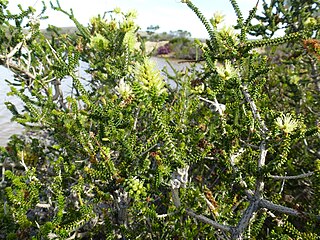
Melaleuca blaeriifolia is an erect to spreading shrub in the myrtle family, Myrtaceae and is endemic to a small area in the south-west of Western Australia. It has small leaves and small greenish-yellow flowerheads.

Melaleuca laxiflora, commonly known as narrow-leaved paperbark, is a woody, spreading shrub in the myrtle family, Myrtaceae and is endemic to the south-west of Western Australia. It is distinguished by its loosely arranged, mostly lateral pink flower spikes and its smooth, fleshy, oil-dotted leaves. It is often cultivated because of its hardiness and attractive flowers.

Melaleuca bracteosa is a low, spreading shrub in the myrtle family, Myrtaceae and is endemic to the south-west of Western Australia. It has tiny, fleshy, non-prickly leaves and cream flowerheads.

Melaleuca ciliosa is a small shrub in the myrtle family, Myrtaceae and is endemic to the south-west of Western Australia. It has bright or pale yellow flowers, an unusual calyx and leaves that are slightly hairy, especially around the edges.

Melaleuca concinna is a small shrub in the myrtle family Myrtaceae and is endemic to the south-west of Western Australia. Its species name translates as " neat" or "pretty" and it is distinguished by having many heads of pink flowers in late spring followed by spherical clusters of woody fruits.
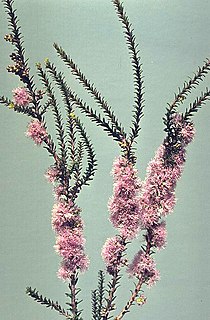
Melaleuca depauperata is a shrub in the myrtle family, Myrtaceae and is endemic to the south-west of Western Australia. It has small, fleshy leaves and purple to pink flowers on short stalks along the branches.

Melaleuca pauciflora is a shrub in the myrtle family Myrtaceae, endemic to the south-west of Western Australia. Its decussate leaf arrangement and its small heads of white flowers on the sides of its branches are diagnostic. This is probably the least spectacular of all the melaleucas.

Melaleuca sparsiflora is a shrub in the myrtle family Myrtaceae, and is endemic to the south-west of Western Australia. It generally grows in heavy soils on the edges of salt lakes and has only one or two flowers at the ends of it branches, unlike the many-flowered heads or spikes of others in the genus Melaleuca.
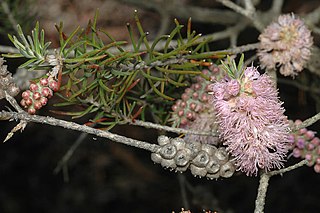
Melaleuca subfalcata is a shrub in the myrtle family Myrtaceae, and is endemic to the south of Western Australia. It has fibrous bark and pink to purple flowers in spikes, mostly on the side branches.
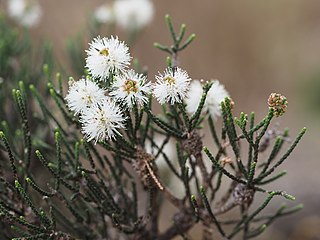
Melaleuca thyoides, commonly known as salt lake honey-myrtle is a plant in the myrtle family, Myrtaceae and is endemic to the south-west of Western Australia. It is an erect shrub with grey, papery or fibrous bark and very small, overlapping leaves on thin branchlets. It is a salt tolerant species often found on the edges of salt lakes.

Beaufortia cyrtodonta, commonly known as Stirling Range bottlebrush, is a plant in the myrtle family, Myrtaceae and is endemic to the south-west of Western Australia. It is a compact shrub with crowded leaves which appear greyish due to their covering of fine, soft hairs. It has heads of red flowers in spring and occurs in the Stirling Range district.
Verticordia densiflora var. cespitosa is a flowering plant in the myrtle family, Myrtaceae and is endemic to the south-west of Western Australia. It is a shrub with small leaves and pink, or pink and white flowers. It is one of five varieties of the species Verticordia densiflora.

Verticordia fimbrilepis, commonly known as shy featherflower, is a flowering plant in the myrtle family, Myrtaceae and is endemic to the south-west of Western Australia. It is a small, bushy shrub with one openly branched main stem at its base, small, pointed leaves and rounded groups of pink flowers near the ends of the branches.
Verticordia huegelii var. stylosa, commonly known as variegated featherflower, is a flowering plant in the myrtle family, Myrtaceae and is endemic to the south-west of Western Australia. It is a single-stemmed shrub with its growth form depending on its surroundings. It is similar to other varieties of the species but differs in its flower colour and the form of the style and staminodes.

Thryptomene mucronulata is a species of flowering plant in the family Myrtaceae and is endemic to Western Australia. It is an erect shrub with upward-pointing, overlapping, egg-shaped leaves with the narrower end towards the base and pink flowers with five petals and ten stamens.
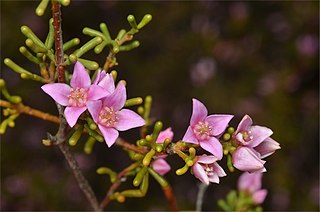
Boronia inornata, commonly known as desert boronia, is a plant in the citrus family, Rutaceae and is endemic to southern Australia. It is an erect shrub with three-part leaves and pink, red or white, four-petalled flowers.
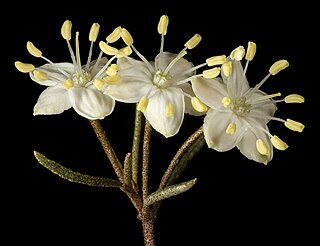
Phebalium filifolium, commonly known as slender phebalium, is a species of upright, rounded shrub that is endemic to Western Australia. It has smooth branchlets covered with silvery scales, more or less cylindrical leaves with silvery scales on the lower side and pale to bright yellow flowers arranged in umbels of between three and eight on the ends of branchlets.
Pultenaea spinulosa is a species of flowering plant in the family Fabaceae and is endemic to the south of Western Australia. It is a shrub with flat, hairy leaves, and uniformly yellow flowers.

Lasiopetalum quinquenervium is a species of flowering plant in the family Malvaceae and is endemic to the south of Western Australia. It is an erect, spreading shrub with hairy stems and leaves, egg-shaped leaves and pink or white flowers.

Olearia passerinoides, commonly known as slender daisy bush, is a species of flowering plant in the family Asteraceae and is endemic to southern continental Australia. It is a slender, sticky shrub with linear leaves, and white or pale mauve and mauve or pink daisy flowers.



















